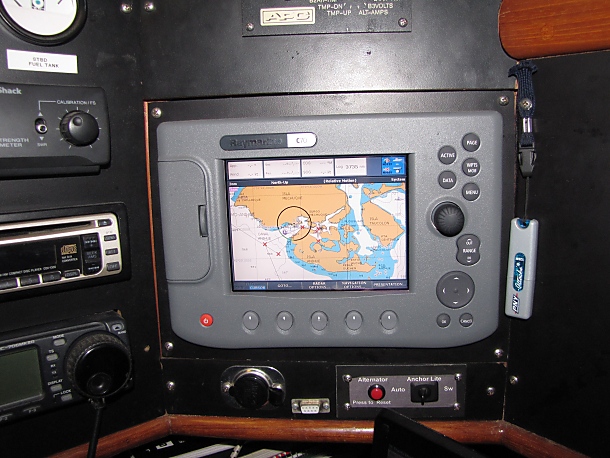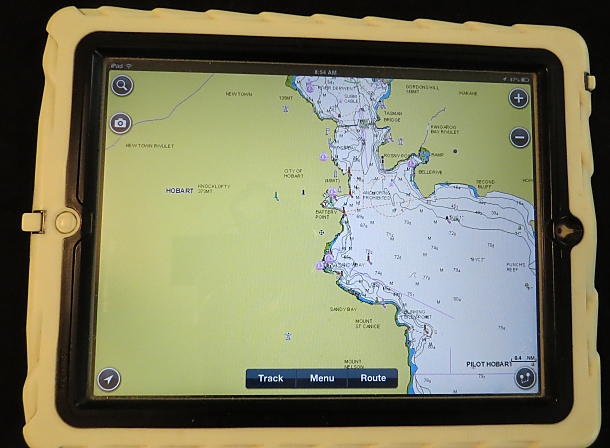The Blue View - Paper Charts
/
When we first moved aboard Nine of Cups, chartplotters were expensive and used a lot of power. Despite being the gadget freak I am, we opted to rely on paper charts. Over the last decade, chartplotters have become less expensive, and it has become pretty rare to find a cruising sailboat that doesn't have one. Now, with the advent of all the navigation apps for the tablet and smart phone devices, many cruisers actually have two or three chart plotters aboard.
After delivering a friend's boat with a chartplotter aboard, we made the change to the electronic navigation world about five years ago with the addition of a Raymarine chartplotter. Then last year, we bought an iPad and the Navionics navigation app and charts. It is a true marvel to be able to glance at the electronic display and see in an instant exactly where we are, and to plot a course simply by moving a cursor around and dropping a waypoint. Nothing to figure out … just touch the screen.
Not only is it easier, but it is less error prone than marking waypoints on a paper chart, determining the latitude and longitude of each point, then calculating the heading and distance between waypoints. We would usually do this together, and check each others' calculations. For a complicated route, this process sometimes took us an hour or two. Now all the calculations are done by the computer, and a route is computed at the push of a button.
So is it time to get rid of all those expensive, heavy paper charts? A lot of our cruising friends no longer invest in paper charts. One chap we met actually decided his compass was now unnecessary, and got rid of it so as to be able to add a larger cup holder. Call us Luddites if you will, but we don't agree with this philosophy.
There are several pitfalls we see when relying solely on electronic charts. The first issue in my mind is a direct result of how easy it is to create a route on a chartplotter. If we are sailing a passage between ports, there is the tendency to zoom in to a high resolution view of the port at each end to plot waypoints, and then to zoom out to view the route connecting the two ports. This low resolution view of the route will miss any small hazards along the route. For example, the passage from Luganville, Vanuatu to Bundaberg, Australia passes right through Chesterfield Reef. This reef is very clearly marked on the paper charts for the area, but is only shown on the higher resolution views on our Raymarine chartplotter. Sailing onto this reef at 6 knots would certainly spoil your nightwatch.
Even if you painstakingly view your route at high resolution, you miss any hazards that are just off your route. If you're driving a motor vessel, this is probably not a problem, but sailboats don't always sail the rhumb line.
In addition, when we both spent an hour or more determining our route, by the time we were finished, we both had a pretty good familiarity with the route and any potential hazards along the way. The plotting process on the chartplotter is a one person activity, so usually only one of us has spent time reviewing the route.
Then there is always the possibility of losing the electronics due to a lightning strike or because of an electrical or equipment malfunction. We have a couple of handheld GPS's aboard as backup, one of which is stored in the microwave in the hopes it might survive a lightning strike. As long as we have the paper charts and a GPS, we'd be no worse off than we were a few years ago before the chartplotter.
And if all else fails, I still have my trusty sextant tucked away. Admittedly, I'm a bit rusty with it – I haven't used it in over a decade. Even when I was at my best, my accuracy was probably no better than +20 miles or so. But as long as we still had a compass, the sextant and the paper charts, we'd be able to jury rig a speed log, and I feel certain we could make landfall somewhere. Of course it would help if the land we were aiming for was big – like say Australia or South America.
Finally, there is one more thought about paper charts. It is not uncommon to meet a fellow cruiser in some remote anchorage who is heading somewhere you've been and is coming from a place you're planning to go. It is very pleasant spending an evening going over the charts, exchanging information on anchorages, navigation, and swapping all the other good info we've each collected. I'm not sure if we can add little notes to our iPad charts, but even if we could, it just wouldn't be the same.





